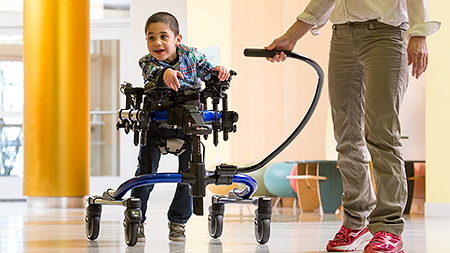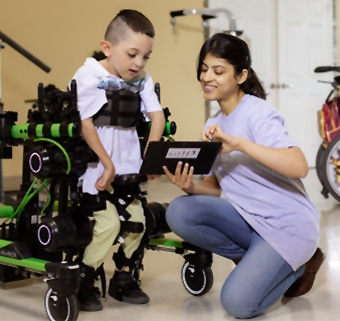Evidence Update: Children's Perspectives on Robotic Gait Training
| April 2015Gait training is a fundamental intervention in pediatric rehabilitation. At present, over-ground assistive devices and treadmills dominate the field, but we’re now seeing emerging robotic technologies that offer solutions to normalize and enhance the quality of gait mainly through the application of motor learning principles and the use of dynamic weight-bearing systems. We need to learn more about these technologies, what they offer and what their limitations might be.
One new qualitative study on robotics has just been published and it carries an important message: the goals and aims of clinicians need to remain sensitive to the goals and needs of the children being treated. Shanon Phelan and her colleagues at the University of Alberta in Canada have just published “What is it like to walk with the help of a robot? Children’s perspectives on robotic gait training technology” in the journal Disability and Rehabilitation, and it’s an important contribution.
 In Phelan’s study, the five participants were children with cerebral palsy with GMFCS levels II or III. These children were sampled from a larger randomized controlled study taking place simultaneously and comparing Lokomat therapy (a treadmill-based, robotic gait trainer with dynamic weight bearing support) to traditional gait training approaches. These five children were first observed at their Lokomat sessions and later took part in an interview.
In Phelan’s study, the five participants were children with cerebral palsy with GMFCS levels II or III. These children were sampled from a larger randomized controlled study taking place simultaneously and comparing Lokomat therapy (a treadmill-based, robotic gait trainer with dynamic weight bearing support) to traditional gait training approaches. These five children were first observed at their Lokomat sessions and later took part in an interview.
From the interview, the researchers describe the children as having “mixed impressions” towards the robotic technology. The children were not completely convinced or excited by the technology and the need to “walk normally” and even expressed some initial anxiety and fears about its use. Additionally, even though the Lokomat provided screen-based games and other forms of engagement, the children became bored after walking in the device.
Notably, what the children valued above the actual therapy was the interaction between themselves and the therapists. This highlights the importance of human touch and relationships, something we all would do well to remember as we evaluate the available interventions for gait training.
Source: Phelan S, Gibson B, Wright F. What is it like to walk with the help of a robot? Children’s perspectives on robotic gait training technology. Disabil Rehabil. 2015. Early Online: 1-10.




